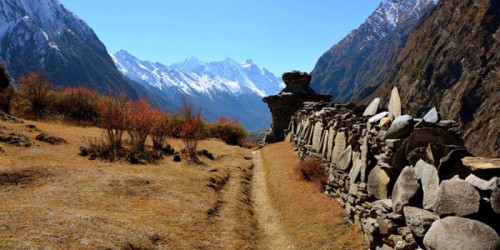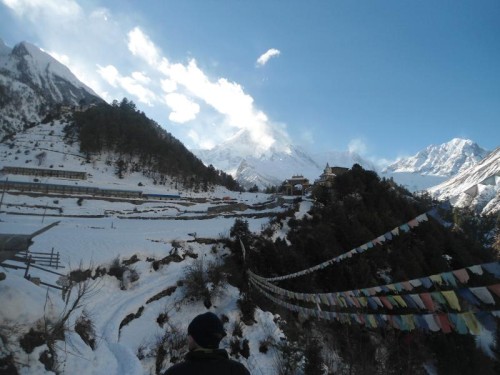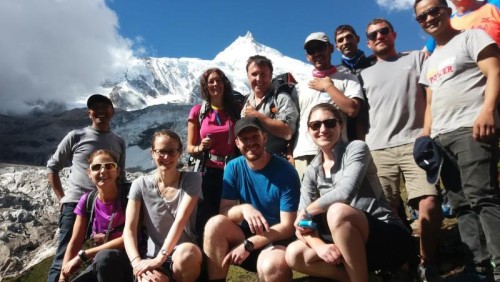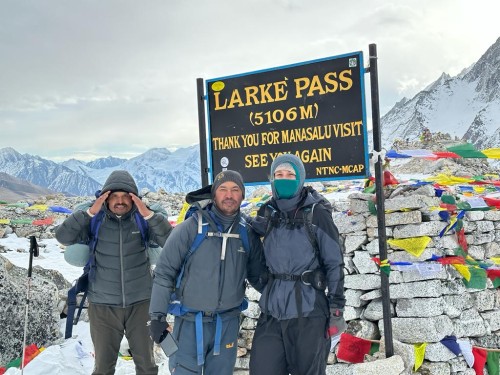Information of Manaslu Conservation Area Project
Manaslu Conservation Area project (MCAP) is protected area of Nepal and located in north center in Nepal and it covering the 1663 square Km in the Mansiri Himalayan range in the Gorkha District. It has established in 2055 B.S. (1998 A.D.). It is bounded by the Tibet border in the north and east, Budi Gandaki River in the south and Annapurna Conservation area is the west border. The area took in mountains, glaciers, water sources and forest in the elevation from 1400 m to 8,156 at the mount Manaslu
This project was initiated by National Trust for Nature Conservation (the king Mahendra Trust for Nature Conservation) a non- government organization and donate by many international trusts. Nowadays, this project conserved by National Trust for Nature Conservation (NTNC) and local people community from local area.
This conservation is worthy of flora and fauna because this conservation is home of 33 species of mammals including Barking Deer, Musk Deer, Snow Leopard, Leopard, Blue Sheep, Himalayan Thaar, Black Beers as well as over 100 species of birds, three species of reptiles, four species of frogs and over 1500 to 2000 species of flower and plant.
How to get the Manaslu Region ?
If you are wondering to get in to the Manaslu region from Kathmandu, here is little information to entry the Manaslu Region. Gorkha Bazaar and Arughat is the starting point to enter the region. There is easily accessible from Kathmandu by public bus or private vehicles. It is North West part and about 140 km far from Kathmandu. It takes approximately 6-7 hours by vehicles to reach out there. Even though Trekking Itineraries are always flexible because there are many starting and ending place, so it may take a little more or less than that. The road condition is quite smooth with blacktop covered until Taribesi. There was rough road between Dhading Besi to Taribesi. From Tari Besi to Arughat road is still rough. That section would be tough during the raining season. Manaslu Region Trekking is not allowed to do individual, it means you have to book with registered trekking company in Kathmandu. So, trekking company arrange you private jeep or public bus depends on your trekking package services
Manaslu Region Trekking Permit
Manaslu Region is situated in Manaslu Conversation Area. It is opened for trekking in 1991 A.D. and remote sector with simple accommodation. Manaslu Region is protected area by Manaslu Conservation Area Project (MCAP) and the government of Nepal controls all trekking activities. So you will need permission to trek in this region.
Manaslu Region is also restricted trekking destination in Nepal. The permit cost of Manaslu region trekking is depends on number of days and months as well as you will need different kinds of permits and issued by Government of Nepal.
Manaslu Restricted Permits
Manaslu Circuit Trek permit cost is USD 100 for the first seven days and additional USD 15 each day during the September to November.
Manaslu Circuit Trek permit cost is USD 75 for the first seven days and additional USD 10 each day during the December to August.
Manaslu Conservation Area Project (MCAP) entrance fees
SAARC Nationals entry fee is 200 Nepali Rupees per person and per person 3000 Nepali Rupees for others Nationals.
Annapurna Conservation Area Project (ACAP) entrance fee for the Manaslu Circuit Trek is:
SAARC Nationals entry fee is 200 Nepali Rupees per person and per person 3000 Nepali Rupees for others Nationals.
Tsum Valley Trekking Permit
Tsum Valley Trek Permits cost is USD 40 first seven days and additional USD 7 each day during the September to November.
Tsum Valley Trek Permits cost is USD 30 first seven days and additional USD 7 each day during the December to August.
All of these permits are compulsory for your trek to Manaslu Region and your Trekking agency help to issued all trekking permits.
Food and Accommodation in Tsum Valley Trek
Manaslu Region is getting popularity day by day similarly Everest, Annapurna and Langtang Trekking but still remote and rural area which makes the costs of goods more expensive than other areas. There are basic and limit accommodations and restaurants along the trekking trail but every year increasing new house and add the room for trekkers. Food and accommodation price are increases if you go higher and the food and accommodation is in Manaslu region is expensive due to transportation but still cheaper than Everest region.
Normally, lodges have basic private rooms (2 beds in one room) for customers with sharing indoor bathroom. Every lodge have food menu and foods items are almost same. We strongly recommended typical Nepali dish “Dal-Bhat” (boiled rice, vegetable, lentil soup) but if you like, you can choose others food from food menu. Most of the lodges produced fresh Vegetables on their garden and serve to costumer. Basically, the cooks are trained but food taste might be bit different than western. Meat is not fresh in the mountain area so you have tried to be vegetarian during the Manaslu region trekking.
You can buy all types of drink in every lodge but the prices goes high as you go higher. You can drink normal water with using a purification tablets. Avoid the alcoholic drinks when you go higher.
Best Season for Tsum Valley Trek
There are two main trekking season for Manaslu Region. Autumn trekking season (September to December) and spring trekking season (March to May) are the best trekking seasons. Even though, beginning of September to end of May are the very good times for the Annapurna base camp Trek. The weather is perfect sunny and warm with wonderful mountains views clean air and not rain and snow compare with other trekking season.
If you want and wish to avoid crowds and enjoy some alone time with nature and culture, you can do this trip during the winter (January and February) also could be an option. The temperature during winter could be little bit cold for most trekkers but the visibility is not bad but there is a high risk to do Manaslu Circuit during the winter season due to lot of snow on Larke (5160 m) top. In the summer season (June to August) is raining but best time for nature lovers. That is why; you can choose your best season for Manaslu Region Trekking depends on your Vacations.
Tsum Valley Trek Difficulty
Manaslu Region Trekking is moderate difficulty fit level adventure trekking route in Nepal. There is one of the popular adventure high pass call Larkey Pass. This is 5106m height. In the winter season, it is very difficult to cross this Larke pass due to lot of snow. This trekking requires good physical condition health and has to able to walk 6-8 hours a day. If compare the Manaslu Trekking route with others trekking route, it is not difficult.
Furthermore, if you have not previous trekking experience, it will be difficult level of trekking but not as tough if you have already trekking experience before this trip. Manaslu Region is remote and less traveled trek compared with Annapurna Region and Everest region Trekking.
Communication in the Manaslu Region
Manaslu region is getting popular trekking destination In Nepal. There are good mobile network services around Manaslu Circuit trekking area but not few places. The internet service will be available whole Region but tea-houses and lodges provide internet with some extra charge. If you have not Nepali SIM card for communication with your family and not use the internet service, our guide help to you for pass the massage because always our guide have cellular phone and he contact to Kathmandu trekking office about to know the trek and your health condition as well as we help any kinds of problem during the trek.
Hence, travelling is important things in life so we make sure you about safe and healthy during the trekking in Nepal. Nowadays, you can get the local SIM card in Kathmandu airport after arrival to use the 3g and 4g internet service because most of the trekking routes in Nepal have Mobile Network service. If you need Nepali SIM, we can provide to you for your trekking but you have to tell us before leave the trekking.
Acclimatization
High altitude sickness is common problem in the high Himalayan area when you go as higher elevation. It is appears very quickly but symptoms are preventable. If you have previous high altitude trekking experience, it might be best but if not trek in above three thousand meters high you need to prevention of the high altitude sickness. You need a extra suitable acclimatization days to complete the trip and Walk slowly, drink plenty of water, don’t drink alcohol, go higher and sleep low elevation as well as spend 2 nights on every 500 meters above than 3500 meters heights are prevent the altitude sickness during the trekking in Nepal. All our trekking itineraries are flexible with acclimatization days and first priority for your health and safety to complete the trek without any problem. We provide you basic medicine to support for emergency rescue, if situation gets worse.
Hence, every day you have inform to your Guide or Leader about your health condition and he will response to decide whether and your overall health condition to continue the trip or return back.
Tipping information
The Guide, porter, driver and all workers who are working in tourism filed, they except some tips during your Tour Trekking and others activities in Nepal. Tipping is judgment of workers from travelers and workers offers the tips end of the trek. Travelers tips 10% of their payable amount but you can give to them depend on their services.
Hence, it is important to High Pass Adventure working team who take care to you all the time during the visiting in Nepal, motivated with outstanding service and offer inspiring trip in a lifetime experience.
Trip extension
If you have extra time after complete the trek, you can do different activities or different short trek in Nepal. We have many short tour packages and adventure activities such as Chitwan National park and Bardiya National Park for Jungle safari tours. You can visit Pokhara city, Nagarkot Hiking, Dhampus hiking or day Rafting tripin Trisuli River.
Adventure activities are like paragliding, canoeing, Ultra light flight, Bungee Jump and Mountain Biking. These all package are extra activities as optional tours and not included in your package cost. If you will do these activities after the trip with us, we arrange at a reasonable cost and we give to you good discount.
Trekking Gear List
Travel equipment are necessary to pack before you travel. We hope it is too much to carry from your home to others country but some are the necessary equipment can be hired or buy in Kathmandu around Thamel.
These general equipment are for all seasons while on trekking in Nepal, but may be different as per the different season and duration of trekking routes on your chosen trip.
Documents:
-Passport and 4 passport size photos
-Travel insurance details (in case an emergency evacuation if needed)
-Boarding passes for flights
-Driver’s license (if needed)
-Cash USD
-Credit/Debit Card (Ensure you have $500 on your card incase an emergency helicopter evacuation is needed)
Sleeping:
-Sleeping bag (Comfort rating -15 Celsius recommended)
-Sleeping bag liner (Optional)
Footwear:
-Trekking boots: one pair lightweight
-Sandals for city and tea house footwear
-Shoes for the plane and tea houses (Optional)
-Gaiters for hiking in winter to the base camp
-Thin, lightweight inner socks
-Thick, warm wool hiking socks
Clothing for body:
Please make sure that you have non-cotton clothing for trekking.
-Base-layer t-shirts (e.g. running t-shirts)
-Fleece/Windproof jacket
-Waterproof jacket
-Down jacket for warmth
-Travel clothes and City Wear
-Underwear
-Base-layer trousers (optional)
-Waterproof trousers
-Trekking trousers
-Trekking shorts (Optional)
-Gloves and wool hat
-bandanna or scarf
Health Requirements (Basic First Aid Kit)
-First-aid kit; should contain lip salve, Aspirin, Band Aids, anti-histamine, Imodium or similar tablets for mild cases of diarrhea
-Re-hydration powder, extra prescription drugs you may be taking if any particular
-Wet wipes for cleaning can be purchased in Kathmandu
Others:
-Sunglasses and Sun cream
-Towel
-Book (reading and writing materials)
-MP-3 /Music, headphones and ear plug (who know some people on group are snoring) as optional.
-Travel wash
-Hand sanitizer, wet wipes
-A day bag: 35 liters
-A duffel or rucksack with straps to go over your back (Max 12 kg of weight for porters to carry)
-Dry Liner or Dry Bag
-Water bottle/thermos/ camel bag: At least 2 L. Nalgen bottles best.
General Toiletries
-Toilet papers/ tissue
-Contact lenses, Glasses (if needed)
-1 medium sized quick drying towel
-Tooth brush/paste (preferably biodegradable)
-Multipurpose soaps (preferably biodegradable)
-Nail clippers
-Face and body moisturizer
-Feminine hygiene products
-Small mirror
-On Personal Hygiene
-Wet wipes (baby wipes)
-Anti-bacterial hands wash
Others (optional)
-Trekking Poles
-Large plastic bags – for keeping items dry inside your kit / duffel bag
-Travel game i.e. chess, backgammon, and scrabble. (for luxuries)
-Binoculars (for luxuries)
-Trail Map/Guide book (if you are alone)




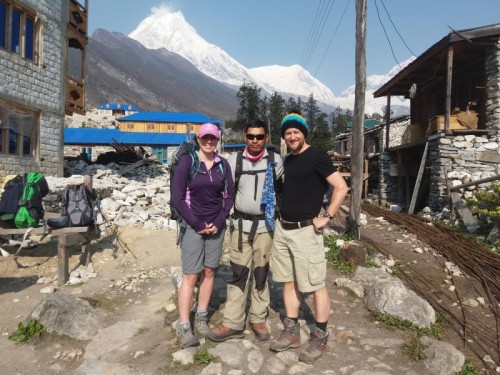


 USD 1050
USD 1050